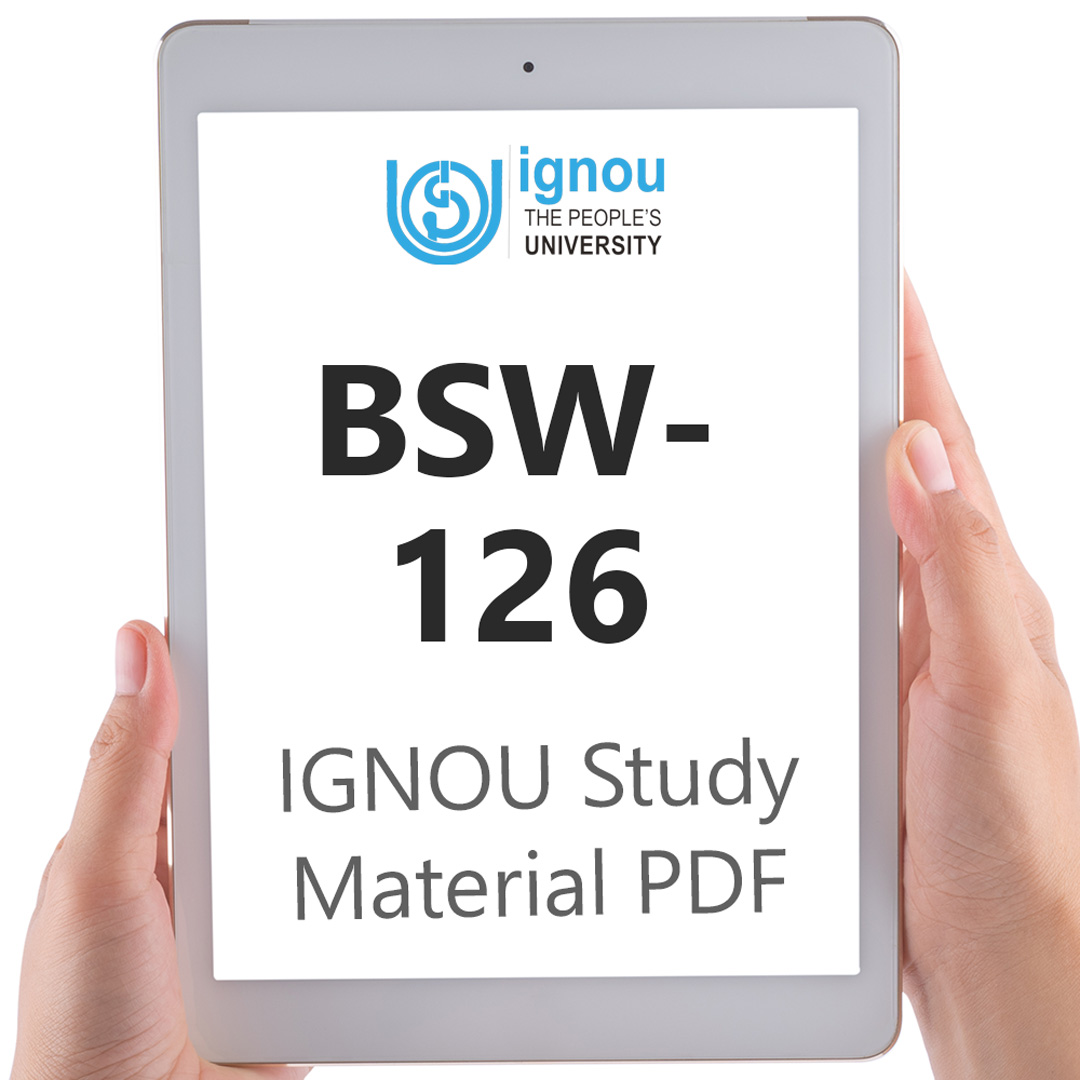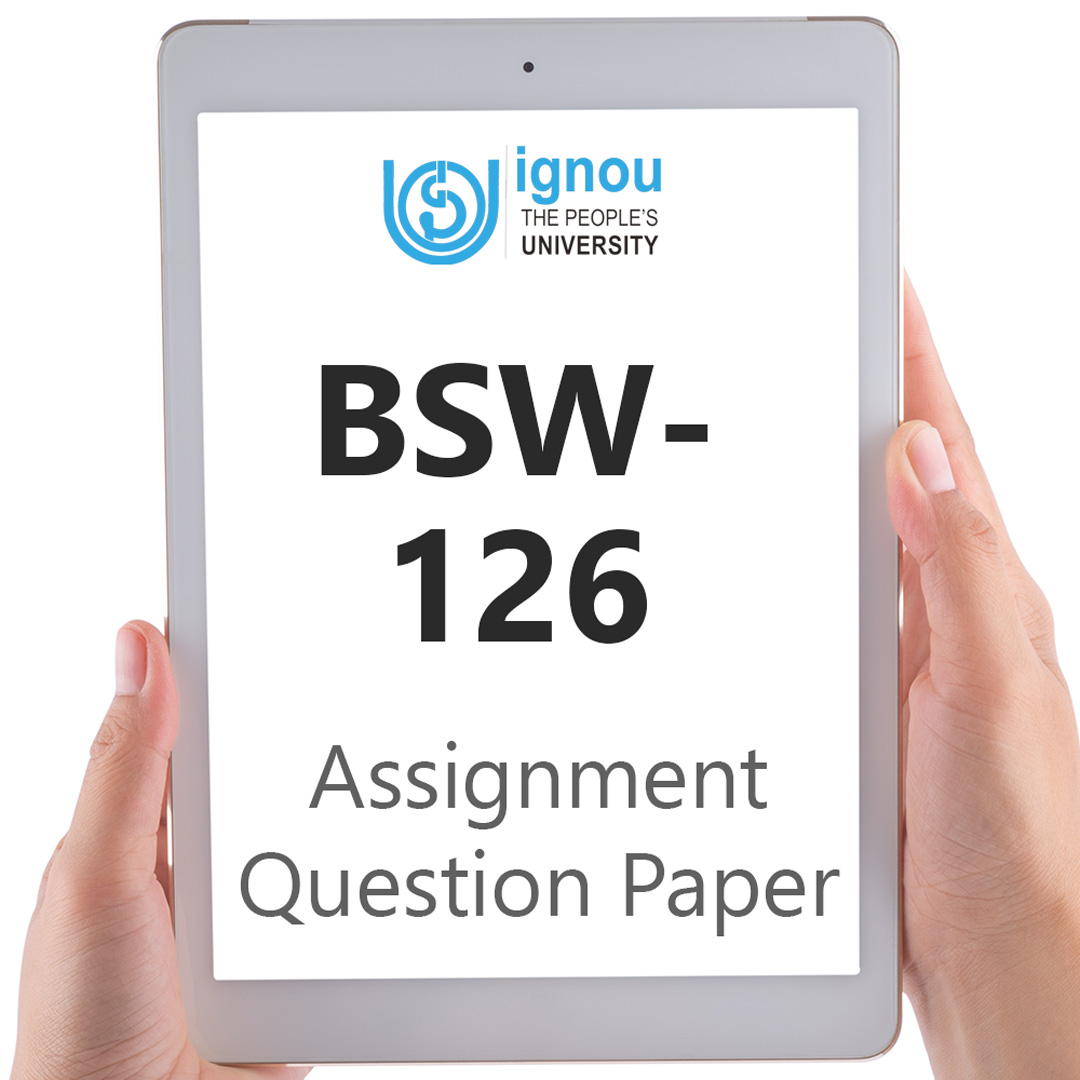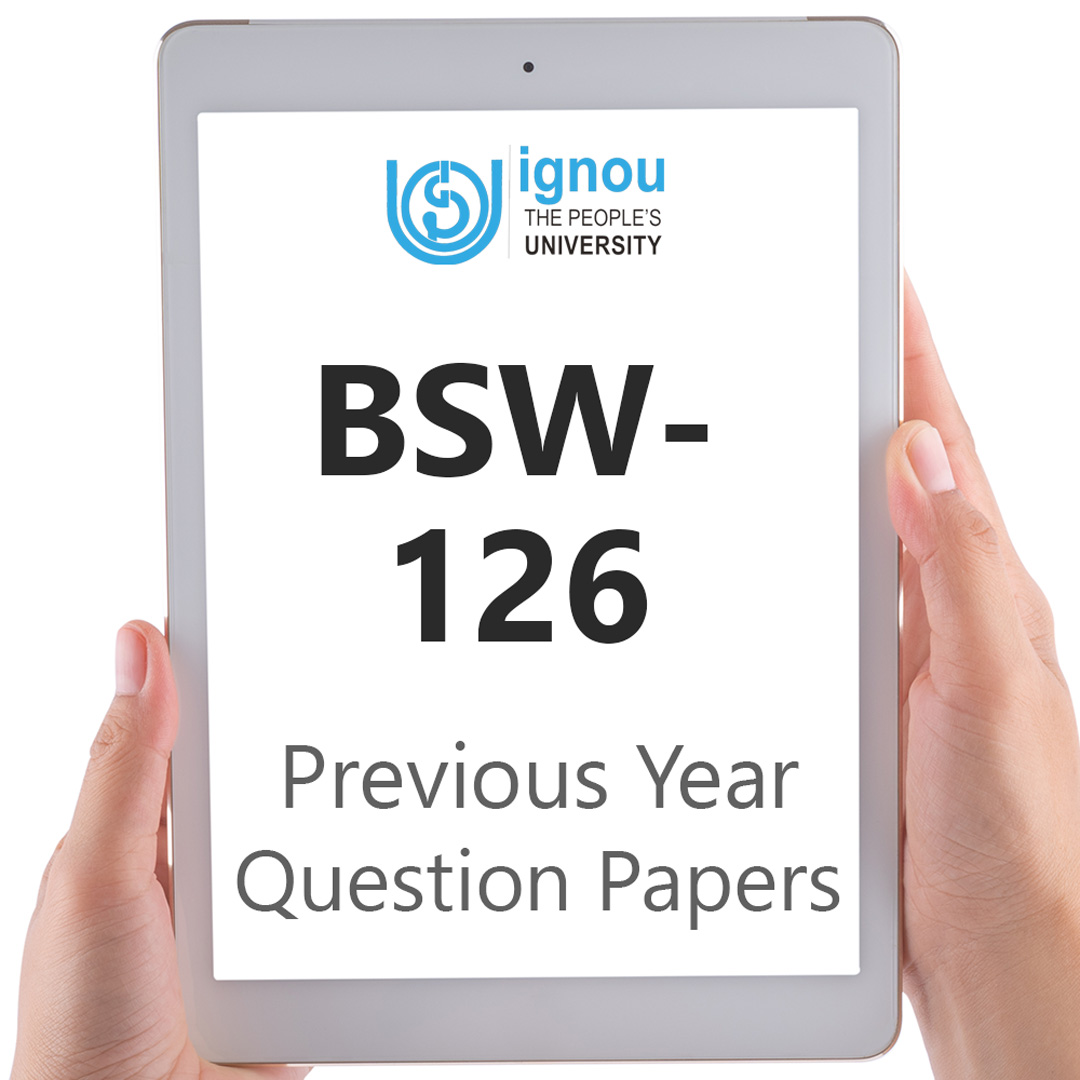If you are looking for BSW-126 IGNOU Solved Assignment solution for the subject Social Work in Family Setting, you have come to the right place. BSW-126 solution on this page applies to 2022-23 session students studying in BSWG courses of IGNOU.
BSW-126 Solved Assignment Solution by Gyaniversity
Assignment Code: BSW-126/TMA/2022-23
Course Code: BSW-126
Assignment Name: Social Work in Family Setting
Year: 2022-2023
Verification Status: Verified by Professor
Answer any five of the following questions in about 300 words each. 20x5
Q1) Discuss the meaning, need and advantages of Family Life Education.
Ans) The term "family life education" refers to a variety of formal and informal initiatives that help people prepare for the obligations and roles that come with being a family member. The field of family life education is vast and adaptable. Family life education can comprise anything that promotes the whole development and well-being of the family, including its physical, mental, emotional, economic, and spiritual welfare. The program's objectives are frequently general in nature.
Need of Family Life Education
Family life education is undoubtedly a young discipline that is headed further towards the professional end of the continuum. Every person needs to be educated about family life. Every person works between eight and ten hours a day to make a living. For this, we spend years studying a variety of courses. Each and every person needs to have a formal and required orientation. Numerous settings around the world, including India, employ thousands of full-time employees with specific qualifications as family life educators.
Advantages of Family Life Education
Despite variations in its structure and operation, the family has always existed as a fundamental social unit among humans. Of course, there isn't a general pattern. Families can be monogamous or polygamous, nuclear, or extended. Compared to past generations, adolescents are growing up in a world where they will have to make more independent decisions. They frequently live more intrepidly, make decisions and take chances, and gain knowledge through their own mistakes rather than those of others.
Most civilizations need to redefine the function of adult family members at the current rate of societal development. Parents are currently being forced to re-evaluate their duties and to make accommodations for the needs of changing family structure and functions, where tradition traditionally dictated the rules for family behaviour. The family life cycle's pervasiveness serves as the foundation for the family life education programme. New learning requirements arise with each cycle phase. These learning requirements were previously addressed by informal learning activities like reading, consulting with peers and experts, and reflecting on personal experience.
Q2) Describe the theories of personality development.
Ans) A distinctive quality of an individual is the development of their personality. Personality development is approached by different psychologists from various angles or views.
Freud’s Theory
Sigmund Freud made the biggest contribution to this field. He defined "personality" as an individual's conscious, preconscious, and unconscious states.
Id, Ego, and Superego
Freud also held that the id, ego, and super ego three interdependent processes are the foundation of human personality.
The unconscious source of psychic power is known as the id. On this psychic energy, the other two systems run. The "life" or sex instinct and the "death" or violent impulse are two of a man's primary instincts. These two impulses provide a man with all of the motivation he needs.
The manager of personality is the ego. It complies with reality's rules. It chooses, chooses, and determines how to satisfy the instincts as well as how to control them.
Super ego operates according to moral standards. It stands for societal values. The interconnections between these systems lead to human personality.
Social Cognitive Theories
The phrase "psychoanalytic theory" is broad and encompasses cognitive psychology, social learning theories, and behavioural theories. Theorists of learning concentrated on observable behaviour. They emphasised the importance of upbringing in personality formation. John B. Watson and B.F. Skinner, who were pioneers in this field, thought that behaviour is formed by a single stimulus-response link. They emphasised the value of reinforcement while ignoring the part that consciousness plays in behaviour. The majority of learning theorists adopted this field's pioneers' methods.
Drive Reduction Theory
Dollard and Miller suggested this idea. A person who is driven by drives discovers ways to curb them. Drive reduction offers incentives and positive reinforcement. This then fuels other drives. The person absorbs new responses and behavioural patterns from our social environment in this way. His or her personality suitably evolves as a result.
Carl Roger’s Self Theory
The Self-Theory was put forth by Carl Rogers to explain how personalities evolve. We encounter a variety of events in our environment every day and every minute. Our behaviour is determined by how we perceive and interpret these experiences. Self-concept development is a protracted and ongoing process. Our self-concept determines whether we regard an experience as positive or bad. Through interactions with social experiences, a person's self-concept is established.
Self-Actualisation Theory
Abraham Maslow's theory of the hierarchy of needs is the most well-known theory on self-actualization. He had the opinion that the realisation of inborn potentials is what determines a person's personality. According to his theory, every human being has requirements that are structured from fundamental to complicated in terms of importance or hierarchy.
Q3) Explain the concept, need and importance of sexual health education.
Ans) Sexual health education teaches students about human sexuality's biological, psychological, sociocultural, and moral elements. It emphasises self-awareness, personal relationships, sexual development, reproduction, and sexual behaviour. Sexuality education focuses on humans. It's the function of the complete personality, which includes the reproductive system, beliefs about being a woman or a man, and same-sex and opposite-sex relationships.
Need of Sexual Health Education
Teens often worry about their looks. Some may feel taller or shorter than their friends. Others may think they're unsightly and awkward, leading to social rejection. An early-maturing teen may feel self-conscious about her larger breasts than her peers. Youth worry about their growth and attractiveness. Any change in their routine can distress them. Although natural, adolescent change and growth raise concern and demand attention.
Body image is how a person views his/her appearance. Size, shape, skin colour, height, and other bodily traits are established by inheritance, but the appearance of one's body is largely impacted by sociocultural factors. Role models affect adolescents' body image. Teenagers worry if their body components don't match their dream guy or woman. Young people need to know that personality is more than looks.
Importance of Sexual Health Education
It is impossible to overstate the significance of sexual health to education in today's culture. We frequently hear through the media and personal experience about the different issues brought on by sex-related misunderstandings. Many people, especially teenagers and young adults, are unsure about what sex is and the roles it plays in both the individual and society at large.
These sources include the media, parents, friends, and even the peer group. These sources can occasionally be mistaken about sex and uninformed of it themselves. There are vested interests in other sources. This is especially true of the mass media, which is aware that glamourized and exaggerated sex is profitable. It must also be acknowledged that certain aspects of contemporary society enable the media to slant the conversation around sex-related topics.
These include the postponement of marriage in contemporary societies, urbanisation, migration for employment and education, the rise in the proportion of women in the workforce, among other things. The value systems of contemporary cultures have likewise changed. The individual is allowed more autonomy and independence when communal control over them is reduced. People are not supposed to meddle in another person's private life unless that person explicitly permits it.
Q4) Highlight the social changes affecting Indian family.
Ans) One of the most significant components of Indian society's fabric has always been and continues to be the family. The family in India is not just an institutional structure of our society; it has a deep value because of the relationship that binds the individual to his family and the scope of the influence and authority that the family wields. The family has undoubtedly helped keep Indian society and culture stable.
The family has been severely impacted by the industrialization process and the ensuing urbanisation and commercialization. The family has been impacted by migration to urban regions, the development of slums, the shift from caste-based and hereditary jobs to new employment patterns provided by technical advancements, the fierce battle for survival, and many other economic developments.
Change in Traditional Functions
Other organisations, such as schools, day-care facilities, retail establishments, and entertainment venues, etc., are assuming many of the responsibilities once carried out by the conventional family. The roles played or anticipated by the various family members is a significant aspect of the family that has been impacted by the social and economic developments in society. It is no longer customary to assign roles based on sex, age, or kinship. The conventional position of the wife has evolved as more and more women take on careers outside the home.
Relationships among family members have undoubtedly been impacted by the shifts in roles. Relationships have also been impacted by the ideas of freedom, individuality, and individual rights. The attitudes of self-centeredness, assertion of individual rights, clamour for equality, and the right to self-determination, among others, are replacing the attitudes of implicit obedience to elders, concern for others, self-denial for the sake of others in the family, acceptances of the authority of parents, and superior status of the male.
Alternative Family Patterns
The existence of a variety of family types, from the most conventional extended families with tight, gender-based sex roles to the modern dual professional families based on liberal, equal sex roles and to adults cohabiting without marriage, is one of the most noticeable aspects of current society. "Alternative family patterns" refers to family dynamics brought about by socioeconomic factors or uncontrollable human circumstances.
The following family variations are most frequently seen in India:
Single Parent Families
Female Headed Households
Dual Earner/Career Families
Childless Families
Adoptive Families
Q5) Delineate the various methods of family planning being commonly used by people.
Ans) Contraception and family planning methods are preventative measures to assist couples in avoiding unintended pregnancies. There are numerous techniques that people frequently employ.
Condom: The most common barrier method utilised by both men and women worldwide is the condom. It is referred to in India by the brand name NIRODH, which is a Sanskrit word for "prevention." A basic, side-effect-free method of contraception known as "spacing" that is effective and simple is the condom. Condoms also shield both men and women against sexually transmitted diseases in addition to preventing pregnancy.
Diaphragm: A vaginal wall is the diaphragm. In 1882, a German physician created it. It is a shallow cap made of plastic or synthetic rubber. It has a flexible metal or spring-based rim. A lady must be fitted with a diaphragm that is the right size. Before sexual activity, the diaphragm is placed, and it must stay there for at least 6 hours following the activity. The diaphragm is always used in conjunction with spermicidal jelly. Side effects are almost non-existent.
Intra-Uterine Devices: The IUDs are medical devices that prevent conception by inserting an external body into the uterus. IUDs come in two basic varieties: "non-medicated" and "medicated." Typically, both are constructed of polyethylene or another type of poly moss. The bioactive or medicated IUDs also emit metal ions or hormones.
Hormonal Contraceptives: The best spacing methods of contraception are hormonal contraceptives when used correctly. They offer the finest way to ensure that there is time between pregnancies.
Current hormonal contraceptives can be divided into the following categories:
Oral Pills
Combined pill
Progestogen only pill
Post-coital pill
Once-a-month (long acting) pill
Male pill
Depot (Slow Release) Formulations
Injections
Subcutaneous implants
Vaginal rings





